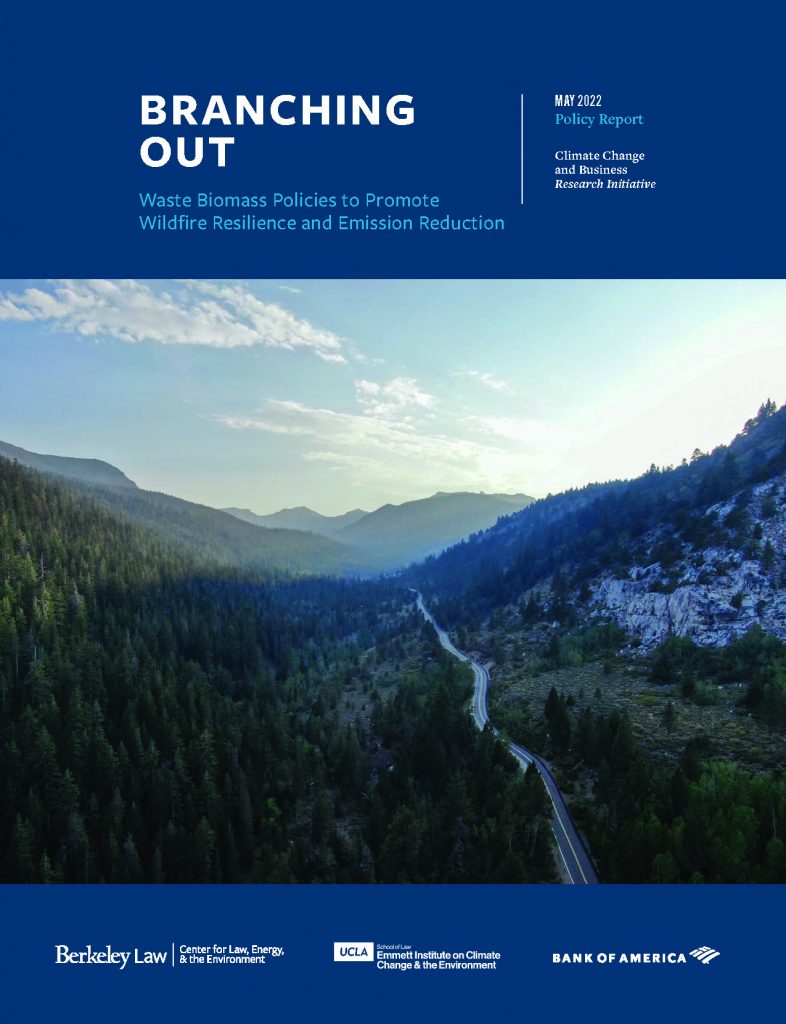Berkeley Law’s Center for Law, Energy and the Environment (CLEE) and UCLA Law’s Emmett Institute on Climate Change & the Environment are releasing today a new policy report: Branching Out: Waste Biomass Policies To Promote Wildfire Resilience and Emission Reduction. The report offers solutions to develop a sustainable market for the residual waste material generated by wildfire treatments on forested and other high fire risk lands.
In response to California’s devastating wildfires over the past several years, government and private landowners are removing excess material at risk of burning, such as dead trees and other vegetation, to create fire breaks that protect lives and buildings. Once cut and stacked, this material risks burning in the next fire, creating additional carbon emissions and air pollution.
Yet rather than leave the waste debris on the forest floor, property owners could potentially use it to create wood products, chips and mulch, or other end uses, which can help defray the costs of wildfire treatments and offset emissions from the production of these products.
To advance this conversation, CLEE and the Emmett Institute convened a small group of experts to discuss opportunities to improve the market for debris material. Several key solutions emerged from the conversation, including for the governor and state legislature to:
- Create a role for the state to serve as a broker for woody feedstock supply, potentially alongside local governments, facilitated through the California Natural Resources Agency.
- Direct the Governor’s Office of Planning and Research to support data mapping and brokerage initiatives for regional supply chain management.
- Dedicate resources towards forest resilience workforce and economic development at local and regional levels.
State agencies are already tackling this issue from several different angles. The Governor’s Office of Planning and Research oversees five pilot projects intended to improve feedstock aggregation mechanisms. The pilot projects are spread throughout the state, and local leaders jointly manage the entities under combined local land use authorities delegated by local government partners. Meanwhile, CAL FIRE’s Business and Workforce Development Grant program offers up to $24 million to projects that advance the wood products market and workforce.
To avoid the risk of unintended negative consequences, such as clearing of healthy forest material that does not promote wildfire resilience, state leaders could deploy the solutions presented in the report over a limited time period, focused narrowly on debris material, in regions with the greatest need for state support (due to material accumulation or potential for community benefits, or a combination of both). They could also ensure they integrate these practices into the broader forest management and wildfire resilience context.
Ultimately, these vegetation management practices are one component of a broader forest and wildfire management strategy that should include prescribed burn and more intentional siting of population centers outside of high fire risk areas. However, by following these recommendations, the state can ensure that when land managers complete vegetation management actions, they have the option to remove and dispose of the residual waste material in a responsible manner, offsetting emissions and reducing demand for new wood products.
For a full list of solutions and more detailed discussion, view the policy report.
CLEE & UCLA Law will host a public webinar on Monday, May 9 from 4:00pm to 5:00pm Pacific Time to discuss report findings and hear from a panel of experts who will share their insights on the problem and potential solutions. Speakers include:
- Jessica Morse, Deputy Secretary, California Natural Resources Agency
- Phil Saksa, Ph.D., Co-founder & Chief Scientist, Blue Forest
Register to join!



